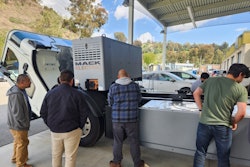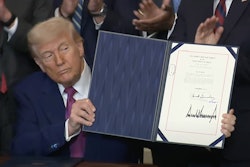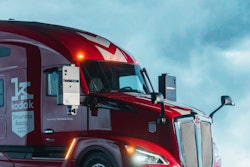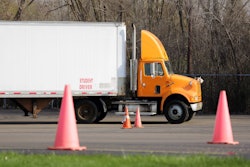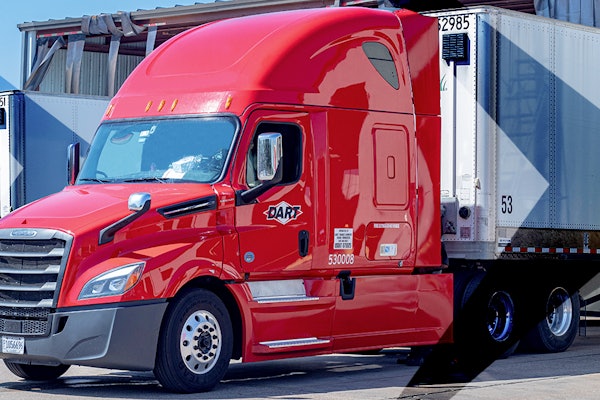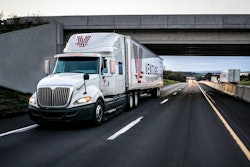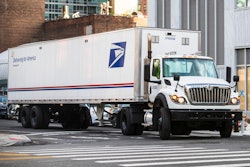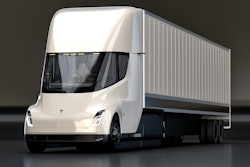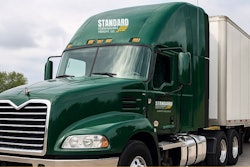While attempts have been made in Congress in recent years to repeal the federal excise tax that adds 12% to the sale of new trucks and trailers, none have come to fruition yet despite the trucking industry's calls for a repeal.
New research from the American Transportation Research Institute dives into how an FET repeal would not only help the trucking industry, but also the environment and highway safety.
Contents of this video
00:00 10-44 intro
00:20 Repealing the 12% federal excise tax (FET) on new trucks
00:51 Explaining the 12% FET
01:24 Origins of the FET
02:37 How much does 12% add to the price of a new truck?
03:55 The Highway Trust Fund (HTF)
05:04 Environmental and safety benefits of repealing FET
08:23 Maintenance cost per mile, new trucks vs older trucks
09:36 Increasing diesel tax
Matt Cole:
How would a repeal of the 12% federal excise tax on new trucks impact the trucking industry?
Jason Cannon:
You're watching CCJ's 10-44, a weekly web episode that brings you the latest trucking industry news and updates from the editors of CCJ. Don't forget to subscribe and hit the bell for notifications, so you'll never miss an installment of 10-44. Hey everybody, welcome back. I'm Jason Cannon, and my co-host is Matt Cole. While attempts have been made in Congress in recent years to repeal the federal excise tax that adds 12% to the cost of all new heavy trucks and trailers, none have come to fruition yet, despite the trucking industry's calls for repeal.
Matt Cole:
In its latest research, the American Transportation Research Institute dove into the origins of the FET and how a hypothetical repeal of the tax would benefit not only the trucking industry, but the environment and highway safety as well.
Jeff Short:
The trucking industry uniquely on its new equipment, pays a federal excise tax that is 12%, and that's on new trucks, new trucking equipment like trailers. Generally, it has to be a Class eight vehicle. It has to be above that weight and can't be used for anything else. So there are a couple loopholes. The law itself isn't terribly straightforward, but that's the general idea. On the largest trucks out there at the first retail sale, you are going to have to pay a 12% excise tax. This tax was first introduced actually in 1917, so it's been a couple years. It started in World War I and the tax was placed on a number of different items. It wasn't just trucks, it was just about anything you can think of from pianos to hunting equipment, they taxed certain types of clothes. When you looked through the list, there are some very strange items in there that were taxed, but all of these taxes have disappeared since World War I, of course, but this one has persisted.
It was at first 3% and then it went up to 8% in the 1950s, and then the 1980s it went up to 12%. Obviously, this is a lot of money. Our analysis on the truck, FET came out of our research advisory committee last year because the industry has been paying the highest taxes into it ever. This is for a number of reasons. Truck prices have gone up, so since this is a percent of the sale, the tax itself has gone up. The amount we pay into it has gone up all the way to about, I'm sorry, 6 billion in revenue per year.
Jason Cannon:
So at today's truck and trailer prices, how much does 12% actually add to the sticker price?
Jeff Short:
So that all depends on obviously what truck you're buying, but for the most part, you're going to be paying at least $20,000 for a new Class eight truck. This may go up all the way to 25,000, maybe even more depending on the cost of the truck, depending on what you have on the truck, on the trailer side, refrigerated trailers, they're going to be quite a bit more than just your standard 53 foot trailer. So those are going to obviously be a little more, that range is probably 5,000 all the way up to over $10,000. So it's quite a bit of money, and this is one thing that caught our research advisory committee's eye. Of course, you've got electric vehicles costing somewhere in the neighborhood of four to $450,000 at 12%, you're getting up towards $50,000, not $25,000, not $20,000. You're getting much, much higher to comply with some of the rules that were coming out in California that no longer apply of course. But if you want to get into these newer vehicles that are so much more expensive, you're still paying that tax.
Matt Cole:
The revenue from the FET goes into the Federal Highway Trust Fund for transportation projects. If it were repealed, how big of a hit would the fund take?
Jeff Short:
The Highway Trust fund, of course, is the mechanism the federal government uses to pay for transportation. We're actually kind of a unique industry in that we pay a lot of money into these roadways that we use, and in some sense that's a good thing. We are able to say, all right, we need money for these critical pieces of freight infrastructure. Obviously, the interstate systems very important. A lot of this money goes towards that. So overall, at $6 billion, which was collected in 2023, this is a drop in the bucket for the federal government for the overall budget, which is somewhere in the neighborhood of $4 trillion that they bring in. This is way less than a fraction of a percent, but for the Highway Trust Fund, this represents about 14%. The tax on gas and diesel make up the vast majority of highway trust fund income, of course, but this is sizable and it would likely have to be replaced in some form or fashion.
Jason Cannon:
While an FET repeal might actually hurt the Highway Trust fund, ATRI found that getting rid of the tax could benefit the environment as well as highway safety.
Jeff Short:
So we feel an FET repeal would have great benefits to both safety and the environment. Ultimately, our analysis lies on the fact that the truck, FET at 12% discourages the purchase of new vehicles. This 12% tax is not unused vehicles, so it gives a discount to the alternative to new vehicles, which is used vehicles. If it were repealed, our belief is that more new trucks would be sold, and thus with those newer trucks out there, the age of the overall fleet would decrease, and that decrease would be accelerated on an annual basis, thus creating environmental and safety benefits. So at the highest level, what we had to do, it was very complex, but we had to look at the entire truck fleet estimate what its age was and how many miles per year each truck drove. And that's a really complicated thing to do. But at the end of the day, the newer trucks were driving about 80,000 miles a year on average, and the older ones were driving much less.
So their impact isn't as much. We were looking at pre 2000 trucks, they're probably going 5,000 miles a year on average because they just can't do that type of job that the new class eights do. So to be fair, we had to look at it that way and model it out. Ultimately, that gave us unique insight into the influence older trucks have on industry-wide safety environmental metrics. So then we went into the stage of the research where we looked at acceleration. What does acceleration mean? Accelerated sales with more new truck sales through a trickle down effect where the oldest vehicles were accelerated out of the population, the age overall decreased. And then what we did was say, all right, how much cleaner or how much safer is a new truck compared to some of the used trucks that are out there? From an environmental perspective, we found that as a truck, FET repeal increases demand for new vehicles.
Industry CO2 will of course decrease at an accelerated rate. That's because newer engines are cleaner. They have to meet certain standards. So our finding was each year the industry adds these newer, cleaner diesel vehicles that they wouldn't have otherwise. A truck repeal a truck, FET repeal would increase the annual emissions reduction by 16%. So what does that mean? Our calculation came out to a cumulative savings of nearly 66 million metric tons of CO2 across 10 years, which is a tremendous amount of CO2. It's a great way to help the environment simply by removing attacks and encouraging folks to buy the latest and greatest trucks that are out there. On the safety side, the accelerated replacement of all trucks added more a DAS, advanced driver assistance systems for collision warning. That's sort of equipment. It added more of that to the industry annually because these items are coming more and more often on new trucks, and you go back 15 years and they're pretty scarce. So what did this come down to in numbers? It prevented nearly 750 crashes per year, and the savings was 13.5 billion in crash costs across 10 years. So this is certainly a good way adding those devices out there to really increase and improve safety with some real numbers.
Matt Cole:
There are also some operational benefits to an FET repeal for fleets that ATRI found.
Jeff Short:
We worked with a company called Decisive to see how much cheaper maintenance would be per mile for newer trucks versus older trucks just to show that benefit as well. And for the older trucks you see closer to a dollar per mile for repair and maintenance, and in the newer trucks it was closer to 15 cents a mile. So that piece of the benefit certainly is going to benefit. It's good for carriers to have a look at that and see how much less you would have to spend on maintenance and repair.
Jason Cannon:
As Jeff mentioned earlier, the highway trust fund would take a pretty big revenue hit if the FET is repealed, but there are some ways the government could recoup that loss.
Jeff Short:
So that could be offset with an increase in the diesel tax. We calculated that the gap could be filled with an increase in the diesel tax of 11.20 cents per gallon. That would bring it up somewhere in the mid 30 range. But if you look at the diesel tax itself, it's been stuck at 24.40 cents per gallon since 1994. If you adjust that for inflation, if they had increased it with inflation, it really should be somewhere in the 50 cent range to begin with. It's likely time for that tax to kind of catch up with where it should be. Certainly, there's been a lot of inflation since, and since this one's a per gallon tax, it has nothing to do with price or cost of the stuff. It's being used to build like roadways. It really does need an adjustment, so this would be a good place for it to have that adjustment and a good reason why to make that adjustment.
Jason Cannon:
That's it for this week's 10-44. You can read more on ccjdigital.com. While you're there, sign up for our newsletter and stay up to date on the latest in trucking industry news and trends. If you have any questions or feedback, please let us know in the comments below. Don't forget to subscribe and hit the bell for notifications so you can catch us again next week.

